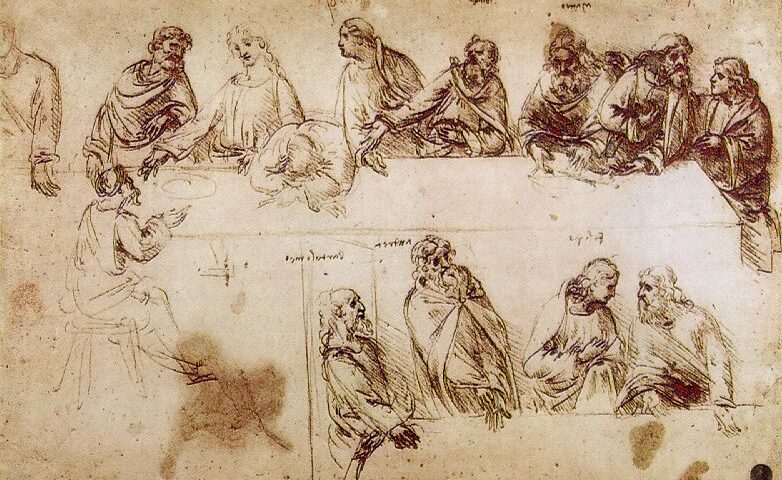The situation is so, on the internet there is also a brownish version of this art piece. The variant I especially like, although the original Study in Venice Academy is done by a red chalk. Maybe it is a sepia-toned photograph as I have not found the original source yet. This introduces us to an another mind-blowing story.
In 1817 J. W. Goethe wrote an essay in German about The Last Supper. At the time G. H. Noehden met and befriended him in Weimar (current Germany). Goethe himself was influenced by Giuseppe Bossi who made a copy of master Leonardo’s Last Supper in an effort to preserve its beauty. [1, 2] Apart from that, Bossi devoted a large part of his life to a study and collection of the works of Leonardo. [3]
J. W. Noehden upon receiving the original of Goethe’s text, prepared a translation to English (authorized by Goethe himself) and added his own introduction. It was published under a name: Observations on Leonardo’s Celebrated Picture of the Last Supper by J. W. Goethe and G. H. Noehden, in 1821.
At the first Noehden’s Introduction p. XXVII-XXXI: Noehden introduces a valuable sketch of the Cenacolo (The Last Supper) and places this drawing in His Majesty’s Library at Buckingham, England. And continues it has always been considered as genuine, placed in King’s collection with other designs and sketches by Leonardo. It’s origin was before in Bonfiglioli collection at Bologna.
Noehden’s description of the piece is following: Sketch of the Cenacolo is drawn with black chalk upon white paper (present appearance is brownish), the sketch measures 10 + 3/4 inches (273,05 mm) in height and 16 + 1/2 inches (419,1 mm) in width (Noehden, p. XXIX). [4]
The Venetian drawing (our Study) is drawn with a red chalk and measures 260 mm in height and 393 mm in length [5] That’s a half inch height and an inch length difference.
What is interesting G. H. Noehden characterizes the Sketch as Leonardo’s autograph without a doubt. Considering it one of designs that were precursors to the immortal work of the Last Supper. Specifically one of the last: for it very nearly approaches, in its outlines, to the character of Picture. He continues: „Our sketch is drawn with black chalk upon white paper: I say white, though its present appearance is brownish, which I ascribe to age. I will, however not maintain, that the paper may not originally have been somewhat tinted.“ And goes on: „The heads are exquisitely drawn and are full of expression. That of the Saviour is perhaps inferior to the rest: and I was led to conclude, that Leonardo, under the impression that was on his mind, scarcely ventured to attempt it, but left it unfinished, even in the sketch.“
Then he mentions there was an engraving of this sketch by Ryland, which was an indifferent performance, not worthy of the original. He states: „Bossi, who had seen the engraving, but not the sketch itself, concluded from the former, on the supposition that it must resemble the original, that the latter could not possibly be the work of Leonardo. But the truth is, that engraving somewhat approaches a caricature, and does not give a just idea of the original drawing.“ From here comes Bossi’s critique: „Among the many things, which excite the suspicion of its being a copy, let it suffice to observe, that while the heads are destitute both of form and of energy of expression, qualities which are never wanting, even in the most careless productions of Leonardo, there is not a part of drapery which does not exhibit the manner of a finished original.“ Noehden counters: „But this fault lies entirely with the engraver: in the original, the heads are delightfully sketched, and with a great care and attention; so that I am persuaded, if Bossi had seen the drawing itself, he would not questioned its being by Leonardo.“
I would like to stop at this place, as Bossi (1777 – 1815) is considered a harsh critic of authenticity and quality of The Study placed in Venice Academy and his legacy continues till the present time. What part of this insight was addressed actually towards Ryland’s depiction in the engraving? His collection stays a source for placement biography of the Study.
And finally: what has happened with the Sketch which was placed in Buckingham, England? Where is it?
„In the engraving, the cup and bread are placed before the Saviour, which are not to be seen in the sketch.“ G. H. Noehden
Literature and comments
[1] Observations on Leonardo Da Vinci’s Celebrated Picture of the Last Supper; p. 1; J. W. Goethe & G. H. Noehden; 1821
[2] Upon Bossi’s copy was created an admirable composition of mosaic currently placed in the Minoritenkirchen, Vienna. This version is particularly valuable, as what Bossi could not abstract from the original LS (because of its deteriorated condition) compelled with careful juxtaposing of the important existing copies. [3] Bossi’s original was destroyed during air raids of 1943.
[3] Observations on Leonardo Da Vinci’s Celebrated Picture of the Last Supper; p. 2-3; J. W. Goethe & G. H. Noehden; 1821
[4] 1 inch = 25,4 mm
[5] Leonardo da Vinci – L’uomo modello del mondo; p. 180; Annalisa Perissa Torrini & col.; 2019

Hello there, I believe your site might be having browser compatibility issues. Amata Tabb Zorana